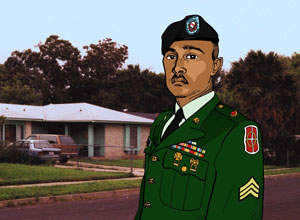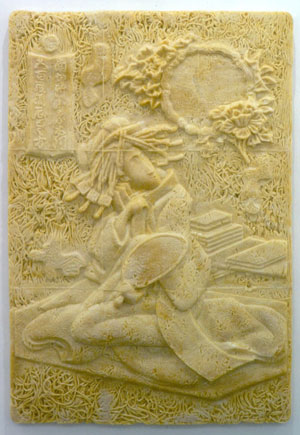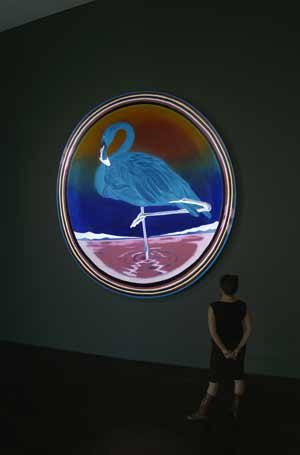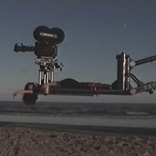The black box model is an apt characterization of WorkSpace, an ongoing series of exhibitions at the Blanton Museum of Art inaugurated along with its new building in April 2006.
In the visual arts, we talk a lot about the white cube, a pristine gallery that promotes a focus on discrete objects displayed in a purportedly neutral space. There are no windows, fixtures, or anything else that might distract from the art enclosed therein. There is no place, no context, except that of Art. There is no time, only eternity. The white cube enshrines objects as Works: autonomous, self-contained, whole. It is the kind of space that signals what is inside it is art, that this art is contemporary, and that no running, touching, or maybe even talking, is allowed.
Artists, curators, and critics have been doing battle with the white cube for decades, if not a whole century. But rather than search for its opposite, perhaps we would do well to think laterally and consider another type of space: the black box. In the terms of theatre, the black box is a flexible performance space that caters to experimental shows with basic technical arrangements – limited sets, simple lighting – and an intimate focus on performance, writing, and storytelling. Everything in the black box can be moved, including the stage and the seats, or removed altogether. Unlike a lavish proscenium theatre production, black box shows don't always require months or years of stagecraft and set construction. Inside the black box, things can happen much faster, generating a more immediate impact.
The black box model is an apt characterization of WorkSpace, an ongoing series of exhibitions at the Blanton Museum of Art inaugurated along with its new building in April 2006. With WorkSpace, the Blanton joins such institutions as the Dallas Museum of Art; the Contemporary Arts Museum, Houston; and the Museum of Modern Art, New York in providing a permanent exhibition space for projects by contemporary artists. WorkSpace rotates every 10 weeks, thereby bringing a constant stream of new material to the museum for visitors to enjoy, contemplate, and question. The series also allows the Blanton's four curators engaged with contemporary art (out of a curatorial staff of six) to present the work that inspires them right now; unlike the Blanton's typical three-year planning process for major exhibitions, WorkSpace is organized as little as six months in advance. Blanton curator of American and contemporary art Annette DiMeo Carlozzi calls this strategy 'curatorial reportage,' a 'view from the field' that punctuates 'America/Americas,' the museum's installation of modern and contemporary art, with work being made in the immediate contemporary moment.
Like the new building, WorkSpace has been anticipated for close to a decade. At the time of the initial plans for the building, Carlozzi was the only curator of contemporary art, so the space (then called the Focus Gallery) would have featured six commissioned works or exhibitions per year under her purview. Plans for other new types of exhibitions developed, however, and soon the projected frequency of contemporary shows in the Focus Gallery started to dwindle. According to Carlozzi, "We were in a quandary because an important part of establishing a vital contemporary program at the Blanton was shrinking." The solution to this problem lay in the blueprints for the building itself. By the final review of the building plan, Gabriel Pérez-Barreiro had joined the Blanton as curator of Latin American art. He also wanted to mount exhibitions for the Focus Gallery. Pérez-Barreiro and Carlozzi realized that a small gallery space on the second floor, which is separated from the main sequence of modern and contemporary art by the E-Lounge and wasn't working well for anything else, could provide a dedicated space for contemporary art. WorkSpace was born.
In its first three installments, WorkSpace has showcased the varied field of contemporary art practice, as well as the diverse interests of the Blanton's curatorial staff. Curators conduct research on an ongoing basis: reading art journals, exhibition catalogs, and scholarly texts; viewing exhibitions in museums and galleries; doing studio visits with artists; and conversing with colleagues in the field. As Carlozzi notes, WorkSpace can be thought of as "the best kind of curatorial research project," in that four curators are involved, each with a unique perspective on developments in the international art world that is constantly being augmented through their travel and study. There are no set criteria for the selection of artists for the series, although it is generally understood that artists will be either at an early stage of their career or, if more advanced, at a point where the invitation will allow them to try something new.
Pérez-Barreiro initiated the WorkSpace series with The Invisible Jump, a site-specific work by Argentinean artist Daniel Joglar. According to Pérez-Barreiro, he selected Joglar because he was 'blown away' by the artist's work on a studio visit with a Blanton group two years ago. Pérez-Barreiro also says he knew Joglar would be flexible and easy to work with, key qualities for the first artist in the series, who also happened to have the first exhibition in a new space, and in a new building, no less. For The Invisible Jump, Joglar suspended an array of objects from the ceiling of the 800-square-foot WorkSpace gallery. Visitors walked underneath gleaming bundles of colored wire, aluminum rods, wooden rings wrapped in evenly spaced black fabric, circles of pins jabbed into pieces of paper — just like they come in the store — and other simple found objects. Each of these was carefully balanced on a piece of fishing line to appear weightless and installed in a module, repeated nine times, that Joglar designed so that no single object appeared to be more important than any other. As Joglar explains in the exhibition brochure, "Everything had to lose its sense of weight."
The Invisible Jump had the feel of a magic show and quite literally created a suspension of disbelief. Joglar's floating objects rotated as visitors moved through the space, reinforcing the dynamic quality of the entire installation and an overall sensation of the miraculous in the air, as if someone just outside the gallery was causing the balls and batons to turn. By encouraging movement on the part of the viewer, The Invisible Jump also gave visitors a chance to survey the WorkSpace gallery itself, which has undergone radical transformations for subsequent exhibitions.

Assistant curator of American and contemporary art Kelly Baum describes her approach to WorkSpace as the 'slow-burn' theory. Throughout her travels to museums and galleries inside and outside of Texas, Baum takes notes and collects postcards and press releases, which she reviews at the end of each trip. According to Baum, 'I eventually sit down, sift through everything, and think carefully about what's stuck with me over the last few days/weeks/months. Usually it's only three or four out of all of the exhibitions I've seen that continue to eat away at me, that make me curious, that cause me to really want to meet the artist and learn more. And when this happens, I know I've found someone/something compelling – for myself, but hopefully for the public as well.' Baum's next step is to do some additional research on potential artists for her exhibition and then to choose three for a series of studio visits. In addition to the work, this meeting is the deciding factor.
Baum's first pick for WorkSpace was Carol Bove, a New York-based artist born in Switzerland with an interest in the 1960s that Baum shares. Bove created two miniature sculpture gardens for the Blanton inspired by the artist's experiences of the sculpture garden at the Museum of Modern Art in New York. The first was installed on a large gray platform immediately visible as one entered the gallery; the second, laid out on a wooden shelf set just above my eye level, was tucked behind a partition wall and enclosed on three sides. Like The Invisible Jump , ''setting' for A. Pomodoro ' also included an element suspended from the ceiling: 214 bronze rods attached to a white suede canopy mapped the configuration of the stars on March 2, over Berlin, where the installation was then being exhibited.
Bove's museums-within-a-museum combined signals for modern sculpture, including tiny grey cubes, clear Plexiglas boxes, and pieces of driftwood, as well as a 'real' sculpture by Arnaldo Pomodoro, an Italian artist who rose to prominence during the 1960s. Pieces of foam, railroad ties, and peacock feathers also were displayed, some anchored to tall, skinny rods or much larger open metal pedestals. In her exhibition brochure essay, Baum compares the platforms Bove chose to present these sculptural markers with theatrical stages. Seen in this light, the objects take on an anthropomorphic quality that, according to Baum, allows them 'to function as sites of empathetic identification on the part of the viewer.' Bove's scaled-down museum displays also invite the viewer to imagine not only entering one of her sculpture gardens, but perhaps rearranging them as well, much like one would approach a dollhouse with its tiny furniture and tea sets. While large-scale sculpture creates an imposing presence experienced through the entire body, objects in miniature engender an irresistible impulse to explore with one's hands. This tactile quality was held in abeyance through the sculptures' placement on a platform near the floor or high on a shelf just out of reach, collapsing the entire gallery space into two distinct worlds explored only with the eye.

WorkSpace turned from the miniature to the gigantic with Black Sun–Green Flamingo, a new, large-scale installation by Argentinean artist Cristián Silva that was curated by Cecilia Brunson, former assistant curator of Latin American art at the Blanton. Silva created two enormous round paintings for WorkSpace that face each other across the gallery, which has been painted black. The paintings reference album cover art for a 1979 Christopher Cross record and feature images that have been made into their opposites: a green flamingo, a black sun. Meant as a meditation on border crossings at the Rio Grande – Silva currently resides in Guadalajara – the work conjures a surreal consular entryway, with the massive round paintings functioning as state seals for a strange and slightly menacing country. The feel of the gallery with Black Sun–Green Flamingo is remarkably different from Bove's or Joglar's installations, demonstrating the range of WorkSpace and the true flexibility of the space.
Annette DiMeo Carlozzi is aiming for further variation with her upcoming WorkSpace exhibition. In January she will present the third part of a trilogy of works by Brooklyn artist Matthew Day Jackson. Much lauded for his contributions to 'Greater New York 2005' at P.S.1 and this year's Whitney Biennial, Jackson was chosen by Carlozzi because she thought his project might make a good contrast to the preceding works by Joglar, Bove, and Silva. Other upcoming exhibitions include new work by Paul Ramirez Jonas, whom the Blanton's current assistant curator of Latin American art, Ursula Davila, met while living in New York. Davila says she was drawn to Jonas' work because of the way it connects with history and ideas of impossibility and failure. Jonas teaches at Bard College, an aspect of his practice that also appeals to Davila, who has a larger interest in the relationship between the production of art and teaching. Baum is working with Los Angeles sculptor Jedediah Caesar for her second WorkSpace project and plans to consider a number of video artists for her third. Pérez-Barreiro is looking to a group of artists from Guatemala for his next WorkSpace exhibition. He says, 'There is some incredible work being done with absolutely no market or institutional support, and I think it will be a great opportunity for one of those artists.'
As Carlozzi notes, WorkSpace is one factor in Austin's seeming "critical mass" in terms of contemporary art. I would go further and wager that this program could be its key. Not only does the museum provide a familiar and therefore comfortable institutional space for nonart publics to encounter contemporary art, but the Blanton also has the resources to publish a brochure for each WorkSpace exhibition and to hold lectures and other educational programs, including tours and gallery talks, on a regular basis. It's not just the bait-and-switch tactic of bringing people who came to the museum for the Remingtons face to face with a room-sized installation created six weeks ago with the hope that they'll like the latter as much as the former, but also the kind of institutional support that can still give smaller spaces a run for their money in terms of enhancing visitors' experiences and drawing in larger crowds. Every gallery space in Austin benefits from this increased visibility for contemporary art, which should inspire enough curiosity in museum visitors to push them further afield. WorkSpace also ensures that the Blanton will remain on regular gallery-goers' radar, too; besides the major exhibitions mounted downstairs, which change with less frequency, WorkSpace makes it so that there's something new to see at the Blanton in terms of contemporary art at least four times every year. If you haven't been to WorkSpace thus far, don't let another show pass you by.
This article was reprinted with permission from the Austin Chronicle .
Images courtesy Blanton Museum of Art.
Amanda Douberley is a PHD student in Art History at UT Austin, and a Contributing Editor to Glasstire.









